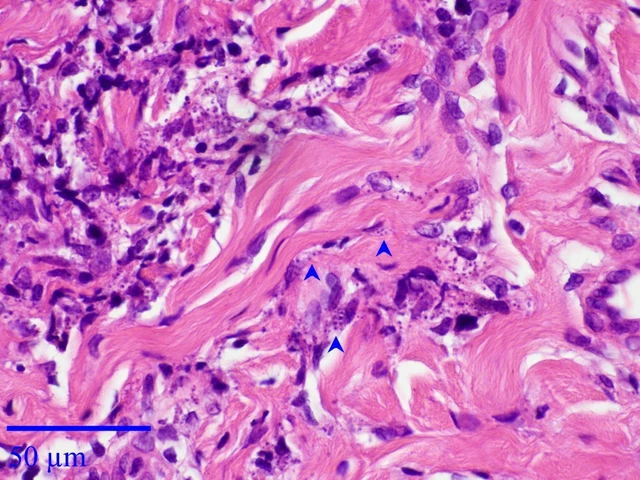Antifungal Treatment Duration Calculator
Compare Treatment Durations
Enter your infection type to see how long different antifungal medications typically take to treat it
Treatment Duration
RecommendedEstimated time to clear the infection based on clinical studies
When you're dealing with a stubborn fungal infection-like ringworm, athlete’s foot, or scalp fungus-your doctor might have prescribed Fulvicin, the brand name for griseofulvin. But if you’ve looked into it, you know it’s not the go-to option anymore. Many patients and doctors are switching to newer drugs that work faster, with fewer side effects and less hassle. So how does Fulvicin stack up against today’s alternatives? And if you’re on it now, should you stay or switch?
What is Fulvicin (Griseofulvin) and how does it work?
Fulvicin is an oral antifungal medication that’s been around since the 1950s. It doesn’t kill fungi outright. Instead, it stops them from growing by interfering with their cell division. That means it takes weeks-sometimes months-to clear an infection because the fungus has to die off naturally as your skin or hair grows out.
It’s mainly used for:
- Scalp ringworm (tinea capitis) in children
- Severe nail fungus (onychomycosis)
- Deep skin fungal infections that don’t respond to topical creams
But here’s the catch: Fulvicin needs to be taken with fatty meals to absorb properly. If you skip the buttered toast or peanut butter sandwich, you might as well not take the pill. And because it’s so slow, treatment can last 6 to 12 weeks for skin infections and up to 6 months for nails. That’s a long time to be on a drug that can cause headaches, nausea, and even liver stress.
Why are doctors moving away from Fulvicin?
Griseofulvin isn’t broken-it just got outpaced. In the last 15 years, newer antifungals like terbinafine, itraconazole, and fluconazole have become the standard. Why? Because they work faster, require shorter courses, and have better safety profiles.
A 2023 study in the Journal of the American Academy of Dermatology reviewed 1,200 cases of tinea capitis in children. Those treated with terbinafine cleared the infection in 4 weeks. Those on griseofulvin needed 8 to 12 weeks-and still had a 15% higher chance of recurrence. That’s not just inconvenient. It’s costly in terms of missed school days and repeated doctor visits.
Also, Fulvicin interacts with a lot of common drugs. Birth control pills, blood thinners, and even some antidepressants can become less effective-or more dangerous-when taken with griseofulvin. That’s a red flag for anyone managing multiple conditions.
Top alternatives to Fulvicin: How they compare
Here are the three most common alternatives used today, and how they stack up against Fulvicin:
| Medication | Typical Treatment Length | Effectiveness (Skin/Nail) | Side Effects | Dosing Convenience |
|---|---|---|---|---|
| Fulvicin (Griseofulvin) | 6-12 weeks (skin) 6+ months (nails) |
70-80% (skin) 50-60% (nails) |
Headache, nausea, liver stress, photosensitivity | Must take with fatty food; multiple daily doses |
| Terbinafine (Lamisil) | 2-4 weeks (skin) 6-12 weeks (nails) |
85-95% (skin) 70-80% (nails) |
Mild stomach upset, rare liver issues | Once daily; no food needed |
| Itraconazole (Sporanox) | 4-6 weeks (skin) 3-6 months (nails) |
80-90% (skin) 65-75% (nails) |
Nausea, dizziness, heart rhythm concerns | Once daily; take with food |
| Fluconazole (Diflucan) | 2-4 weeks (skin) 6-12 months (nails) |
75-85% (skin) 50-60% (nails) |
Headache, upset stomach, rare liver toxicity | Once weekly for nails; no food needed |
Terbinafine is the clear winner for most cases. It’s the most effective, shortest course, and easiest to take. Itraconazole is good for stubborn infections or when terbinafine isn’t tolerated. Fluconazole is often used for yeast-related skin issues or when weekly dosing is preferred.

When is Fulvicin still the right choice?
It’s not all bad news for griseofulvin. There are still situations where it’s preferred:
- Children under 2 years old: Terbinafine isn’t approved for very young kids. Fulvicin remains the go-to for scalp ringworm in infants.
- Allergies or intolerances: If you can’t take terbinafine due to liver concerns or allergic reactions, Fulvicin may be the safest fallback.
- Cost and access: In some countries, griseofulvin is much cheaper than newer drugs. Generic versions cost under $10 for a full course.
- Historical use in specific strains: Rare fungal strains in rural areas sometimes respond better to griseofulvin, especially in regions where newer antifungals aren’t widely available.
But even in these cases, doctors usually try to switch to newer options as soon as possible. For example, a child on Fulvicin for scalp fungus might be switched to terbinafine once they turn 2.
What about natural remedies or topical treatments?
Many people ask: Can I just use tea tree oil, coconut oil, or apple cider vinegar instead?
Topical treatments work well for mild, surface-level infections-like a small patch of athlete’s foot. But they don’t penetrate deep enough to treat scalp fungus or nail infections. That’s why oral medication is needed in those cases.
Natural oils might help with symptoms like itching or redness, but they don’t eliminate the fungus from the root. A 2022 review in Mycoses found that even the strongest plant-based antifungals cleared only 30-40% of nail infections after 6 months-far below the 70%+ rate of oral drugs.
Don’t skip the prescription because you’re worried about side effects. The risks of untreated fungal infections-like spreading to others, permanent nail damage, or secondary bacterial infections-are much higher than the risks of short-term antifungal use.

What should you do if you’re currently on Fulvicin?
If you’re already taking Fulvicin:
- Don’t stop suddenly. Stopping mid-treatment can make the fungus resistant.
- Ask your doctor about switching. If you’ve been on it for 4 weeks with no improvement, it’s time to reconsider.
- Check for interactions. Review all your other medications with your pharmacist. Fulvicin can mess with birth control, blood thinners, and some antidepressants.
- Track your progress. Take photos of the infected area every 2 weeks. If there’s no change after 6 weeks, it’s likely not working.
Most people who switch from Fulvicin to terbinafine see results in half the time. And if you’re treating nail fungus, you’ll be done in months instead of years.
Final thoughts: Is Fulvicin obsolete?
Fulvicin isn’t gone. But it’s no longer the first choice. It’s a backup plan, not a breakthrough. For most adults and older children, terbinafine is faster, more effective, and easier to take. Itraconazole and fluconazole are strong alternatives when terbinafine isn’t suitable.
The real question isn’t whether Fulvicin works. It’s whether you want to wait six months to get better-or four weeks.
Is Fulvicin still prescribed today?
Yes, but rarely as a first option. Doctors still prescribe Fulvicin for very young children, patients with allergies to newer antifungals, or in areas where cost is a major barrier. In most cases, it’s used only after other options have failed or aren’t available.
How long does it take for Fulvicin to work?
For skin infections, you might see improvement after 2-4 weeks, but full clearance usually takes 6-12 weeks. For nail fungus, treatment can last 6 months or longer. The fungus doesn’t die right away-it’s pushed out as new skin or nails grow.
Can I take Fulvicin without food?
No. Fulvicin needs fat to be absorbed properly. Take it with a meal that includes butter, cheese, nuts, or avocado. Taking it on an empty stomach makes it much less effective.
Is terbinafine safer than Fulvicin?
Generally, yes. Terbinafine has fewer drug interactions and a lower risk of liver damage than Fulvicin. It’s also more effective and requires a shorter treatment time. Liver monitoring is still recommended for both, but terbinafine’s side effect profile is better overall.
What happens if I stop taking Fulvicin early?
Stopping early increases the chance the fungus will come back-and it might be harder to treat the second time. Fungi can become resistant to medications if they’re not fully wiped out. Always finish the full course unless your doctor tells you otherwise.
Can I use antifungal creams instead of pills?
Only for mild, surface-level infections like small patches of athlete’s foot or jock itch. For scalp ringworm, nail fungus, or deep skin infections, creams won’t reach the root of the fungus. Oral medication is required for those cases.
Are there any natural alternatives to Fulvicin?
Natural oils like tea tree or coconut oil may reduce itching and redness, but they don’t cure deep fungal infections. Studies show they’re only about 30-40% effective for nail fungus, compared to 70-80% with oral antifungals. Don’t rely on them as a replacement for prescribed treatment.
Next steps: What to do now
If you’re on Fulvicin and wondering if you should switch:
- Make a list of your symptoms and how long you’ve been on the medication.
- Write down any side effects you’ve noticed.
- Bring a list of all other medications you’re taking.
- Ask your doctor: “Is there a faster, more effective option for me?”
Most people who switch to terbinafine feel better in weeks-not months. And if you’re treating a child with scalp fungus, you’ll be glad you didn’t wait.






Billy Tiger
October 31, 2025 at 21:24
Fulvicin is for losers who don't want to take responsibility for their hygiene
Terbinafine works faster and cheaper why are we even talking about this 1950s relic
My cousin took it for nail fungus and still had it after 8 months while I was done in 6 weeks
Stop wasting doctors time and your own life